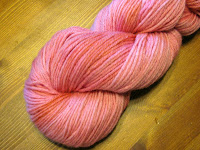I usually use chemicals to dye my yarns; but I've been investigating organic dying a little and thought that I would do a little experiment. So here is what I did:
Step 1: I mixed 4 parts water with 1 part vinegar and let the undyed merino DK wool sit in this bath for about 15 minutes--just to make sure it soaked up the liquid completely.
Step 2: I microwaved the yarn on HI 3 times in 2-minute increments. The original directions that I found at Pioneer Thinking said to simmer the yarn for 1 hour; but I have a fear of felting, so I microwaved, instead. I've never had anything felt up on me in the microwave. The purpose of this is to pre-fix the dye before I add it so that it will "stick" and not bleed out during rinsing/cooling. I let the yarn sit for a couple minutes between microwaving sessions, and then I let it cool down to room temperature before adding my dye. I drained the excess vinegar/water from the dish so that it would cool more quickly.
Step 3: I took beet juice, which I saved from 3 cans of beets ($0.89 per can makes for a pretty cheap dye!) and soaked the freshly-squeezed yarn in it for most of the day (about 6 hours). I used plain old beets, not the pickled kind. Although, come to think of it, the pickled beet juice might kill two birds with one stone if I add just a little more vinegar to the already vinegarized juice. I will have to try that next time. The ratio was 2 cups juice to 1 cup filtered water.
Step 4: Pour the beet juice over the yarn, mix well (I carefully turned the yarn over--with gloves on, of course!--and then pushed down on it to make sure that the juice fully saturated the yarn), and let sit for an hour and a half. I turned the yarn once about half-way through this step to make sure that there was even saturation.
Step 5: I microwaved the yarn again, twice, in 2-minute increments, letting it cool for about a minute between sessions. Then I let it cool back to room temperature.
Step 6: As a final measure, and to make sure that any vegetable remnants that might have been in the beet juice are washed out, I did a quick "shock" soak in iced-cold water in the sink (about 10 minutes). I didn't agitate it much, just enough to move any vegetable particles off of the yarn.
Step 7: I squeezed out excess water and let it dry on a drying rack. Here's the final product. Sadly, the finished product is much, much lighter than I had hoped. Oddly enough, I ended up with some spots of an orangey-ink color in about 5 places on the skein. Not sure why. I think next time I will hold myself back and let the juice sit on the yarn overnight. Maybe there wasn't enough saturation time.
And here's another project from 2 weeks ago. I've been dying (no pun intended!) to show off this little number, which I custom-dyed for Roberta from Tallahassee for an August yarn swap. It's super-gorgeous, and this picture doesn't do the subtle color variations of turquoise justice. 880 yards of lace-wt. merino. Roberta says she LOVES it! I'm so glad. This turned out so well that you can expect to see this little number in my Etsy store for spring.










Gorgeous! What did you use to dye the turquoise?
ReplyDeleteThanks for stopping by and leaving such kind comments. Sorry the beet juice experiment didn't turn out the way you had wanted. Absolutely love, love, LOVE the turqoise yarn. Gorgeous!
ReplyDeletesmiles!
Hi! I am a new follower from Tuesday's blog hops. Glad I came across your blog. I will be back. Blessings...
ReplyDeleteSaved By Love Creations
Hi, I'm your newest follower from to the top tuesday blog hop. Stop by and visit me at healthy living and a balanced you www.aliciahunter.net
ReplyDeleteI've used Kool-aid to dye yarn & it turned out well.
ReplyDeleteThanks for joining the Green Blog Hop!
Jacqie @ talesofthewife.com
Wow this is awesome! I've never dyed yarn before but I've wanted to try. I'll have to look back at my to do list that is a mile long!
ReplyDelete:) :)
You should consider warm water as opposed to cold as the heat makes the dye absorb better, and how about using Kool-aid to dye your wool? The effect should be the same and you can control the saturation based on the number of packets you pour in.
ReplyDelete